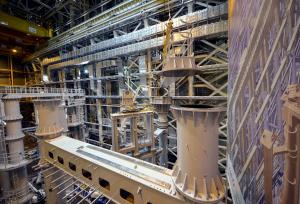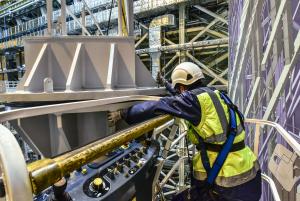Sub-assembly tools
A 12-tonne beam, a crane and a little push
14 Jan 2019
There is nothing remarkable about lifting a 12-tonne beam. Except when it happens in the spectacular setting of the ITER Assembly Hall, and the beam needs to be fitted with extreme precision into a structure as monumental as the ITER sector sub-assembly tools.
Towering 22 metres above ground, the vacuum vessel sector sub-assembly tools (SSATs) are formidable handling machines that will be used to pre-assemble vacuum vessel sectors with a pair of toroidal field coils and thermal shield segments before integration in the machine.
The assembly of SSAT-1 began in November 2017 and is now complete. Work on its identical twin SSAT-2 started in September the following year and is now entering its final phase.
Positioned on both sides of the beam, CNIM specialists precisely align the suspended beam and the massive supporting pillars—an operation that can only be performed manually.
Part of Korea's contribution to ITER, the tools are assembled by French contractor CNIM. Lessons learned from SSAT-1 have reduced assembly time for SSAT-2 by approximately one-third.
On Wednesday 9 January, installation operations began for some of the last elements: two 12-tonne beams that stabilize the massive pillars of the machine.
Click here to watch a video of the installation.



